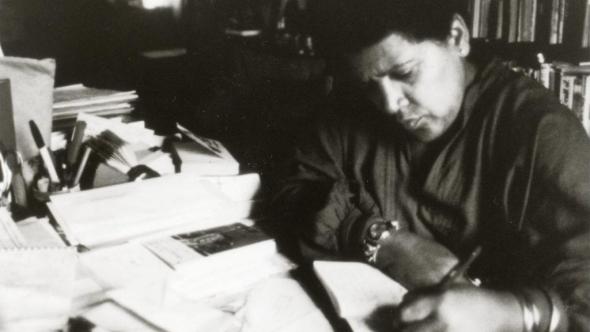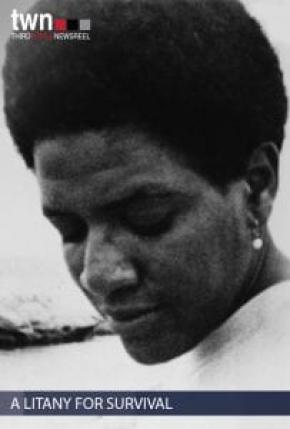Women of Color in Film: An Interview with JT Takagi & Ada Gay Griffin
This post is part of our online forum on the Life and Work of Audre Lorde. In this interview, Keelyn Bradley, the forum’s organizer, speaks with JT Takagi, filmmaker/Executive Director of Third World Newsreel (TWN) and filmmaker Ada Gay Griffin, also a former Executive Director of TWN (1988-1998) and co-director of A Litany For Survival: The Life and Work of Audre Lorde.
 Image from ‘A Litany for Survival’
Image from ‘A Litany for Survival’
Keelyn Bradley: Tell us more about TWN’s role and impact in helping to shape different strands of progressive feminist, anti-racist, and leftist political discourses.
JT Takagi & Ada Gay Griffin: Third World Newsreel (TWN), which began as Newsreel in 1967, was formed out of the need for media that both revealed the reality of the social movements both here and in revolutionary movements abroad – and would work to compel others towards action for change. Starting as a radical film collective, mostly of white leftist filmmakers, it formed alliances with the leading edge of movement groups – from the Black Panthers to the Young Lords, SDS and women’s organizations – and connections with the otherwise blockaded countries of Cuba, China, North Vietnam, Frelimo in Mozambique and more.
From its very start, the organization’s business model was different from a standard capitalist organization or non-profit. Its goal was to make change and survive to fulfill its mission. Its films were considered fringe and potentially dangerous – and in the film world, more agit-prop than “cinematic.” And much like the movements it filmed, it was also the target of FBI investigations and red baiting.
By the mid-1970s, Newsreel transformed into Third World Newsreel, under the leadership of two women of color – Christine Choy and Susan Robeson, and has since then, been led by women of color. Between the legacy of its radical formation and the political nature of many of its films, and its commitment to the idea of “Third World” in its deepest sense, TWN, like the entirety of BIPOC communities here, has been marginalized by the mainstream – but like the communities we stem from, continues the work. The organization focuses on media by and about people of color (aka BIPOC or ALAANA) and social justice, and its aim is social change. It approaches its distribution, exhibition, production and training of broadly diverse multicultural and other historically marginalized communities (immigrant, LGBTQ+) with the aim of bridging what are often siloed issues and groups, and nurturing conscientized BIPOC activist/filmmakers. TWN training graduates include Oscar nominated filmmakers, as well as grassroots organizers and film professors. Whether TWN receives the recognition, our films continue to impact and influence, and the filmmakers who’ve emerged from our programs continue the activist media effort to change this world for the better.
Bradley: We’re experiencing the breaking point of nearly twenty-years of neoliberal austerity policies, which have imposed brutal living conditions on poor and working class peoples under authoritarian governments. How does TWN situate itself aesthetically and politically against these oppressive policies?
Takagi & Griffin: The oppressive policies and structural inequities that underlie the conditions of poor and working class people’s lives here and abroad date from the first invasion of native territories, and the last few decades have exacerbated these conditions. What our older films reveal is the similarity of conditions now with what existed 50 years ago. And there are potential lessons that could be gleaned from the past with the enhanced possibilities of organizing with new technologies. During the pandemic and with the growth of the Black Lives Matter Movement, we’ve embarked on a series called Organizing and Filmmaking, where we stream older TWN films with new ones on similar issues – from gentrification to police brutality to decarceration, and bring elder and new filmmakers and activists together in online talks. We aim at a cross generational pollination of thought and action, and we are working with various groups, from the African American Intellectual History Society (AAIHS) to activist groups to encourage these interactions, which we hope will lead to growth and action.
Bradley: How has the woman-centered film been important to the development of TWN’s film activism and to liberation struggles in general?
 Takagi & Griffin: The original Newsreel was white and male dominated – and it was only due to internal organizing and struggle of a Newsreel women’s caucus that films like The Woman’s Film were made. The formation of Third World Newsreel from Newsreel was due to the struggle of mostly women of color within the organization; and from that point on, women of color have led the organization. It may have only been possible from this ferment that films like A Litany for Survival: The Life and Work of Audre Lorde that focuses on Audre Lorde, the Black feminist warrior poet, or Dreams Deferred: The Sakia Gunn Film Project that details the murder and fight for justice for young LGBTQ+ Sakia Gunn, could be produced or coproduced by TWN. And in the case of the latter, TWN not only coproduced, but ED Dorothy Thigpen, also helped to film the documentary. These films, along with others – Inside Women Inside (1978), which was one of the first films to give voice to incarcerated women, and The Women Outside (1996), which did the same for women impacted by US militarization and the intersection of patriarchy, racism and sexism in Korea, are examples of TWN outcomes. What is key in the films listed here and in the question is the collaboration between the filmmakers and activists that made such films possible; as well as the leadership role of women in the movements themselves – which remains a still often obscured truth, but the one enduring and critical engine of all progressive movements.
Takagi & Griffin: The original Newsreel was white and male dominated – and it was only due to internal organizing and struggle of a Newsreel women’s caucus that films like The Woman’s Film were made. The formation of Third World Newsreel from Newsreel was due to the struggle of mostly women of color within the organization; and from that point on, women of color have led the organization. It may have only been possible from this ferment that films like A Litany for Survival: The Life and Work of Audre Lorde that focuses on Audre Lorde, the Black feminist warrior poet, or Dreams Deferred: The Sakia Gunn Film Project that details the murder and fight for justice for young LGBTQ+ Sakia Gunn, could be produced or coproduced by TWN. And in the case of the latter, TWN not only coproduced, but ED Dorothy Thigpen, also helped to film the documentary. These films, along with others – Inside Women Inside (1978), which was one of the first films to give voice to incarcerated women, and The Women Outside (1996), which did the same for women impacted by US militarization and the intersection of patriarchy, racism and sexism in Korea, are examples of TWN outcomes. What is key in the films listed here and in the question is the collaboration between the filmmakers and activists that made such films possible; as well as the leadership role of women in the movements themselves – which remains a still often obscured truth, but the one enduring and critical engine of all progressive movements.
Regarding the relevance of films to current struggles—TWN’s experience, as noted in the previous question, has been that of often being revelatory to younger activists, seeing TWN’s older films and the organizing depicted, and hearing from elder and new filmmakers and activists today. It is building connections between generations and being able to explore what lessons could be learned from past struggles for today’s efforts. And the contention in the question of less on-the-ground activism and connection is not the case in NYC at least, where there’s growing involvement of emerging activists across the board on the streets.
Bradley: A major aspect of TWN’s mission is its commitment to community arts education. As an organization with a history tied to cutting-edge use of media/film technology to affect social change, what do you see for the future of media activism?
Takagi & Griffin: TWN has continually faced challenges and changes in the field – and corporate owned media control and the pathway to viewers and audiences has always been a hurdle, and perhaps more so now. However, there are teachers, students and community organizers seeking alternative media – groups like your society, for that matter. For TWN, each technological transition – from 16mm film to ¾”, VHS to DVD, and now to digital and streaming, involved a herculean effort for this small media center. But we’re still here. What form our efforts will need to take in the future is yet to be determined. And while it’s hard for us right now to envision a post-covid future that is not bankrupt, an administration not dedicated to killing or harming BIPOC communities, what we can be sure of is that grassroots activists will continue to lead efforts for a better world. And there will continue to be a need for media that presents a history of our struggles, the possibilities we can fight for, along with the diverse voices of our activist communities. And that’s what we aim to keep doing.
Article originally published by Black Perspectives at 17.02.2021